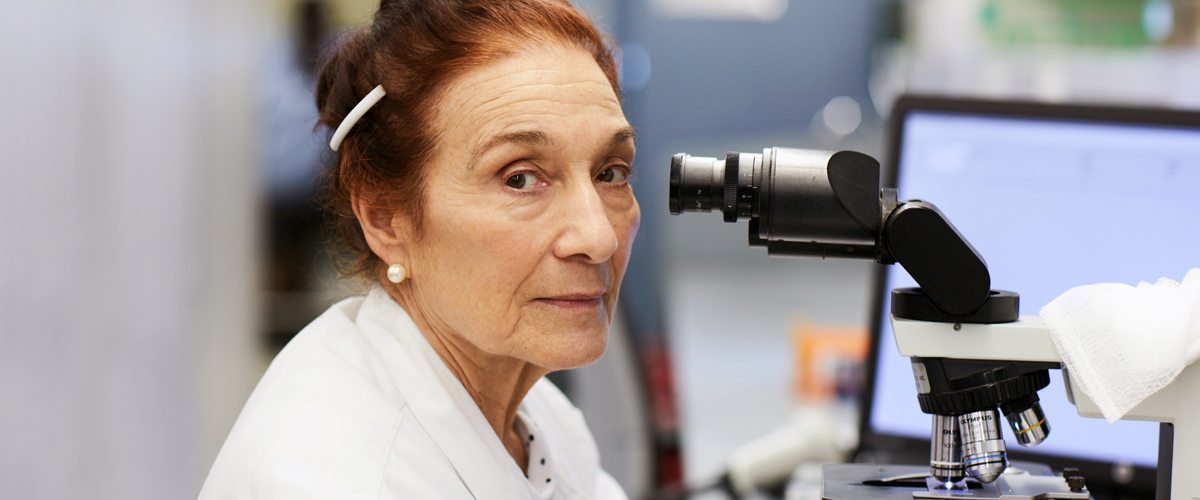Inside NYP: Elaine Manning
The clinical laboratory technologist shares the importance of the human element in her work.


I guess you could say I got my start in my field as a child. I would go into the bathroom while my mother was sleeping and mix Alka-Seltzer and an antiseptic, which I found in the cabinet, and it would foam and change to a pinkish-greenish metallic color. I am lucky I didn’t blow up the place. A cousin who worked in lab technology took me around her lab. I liked seeing things in the microscope and mixing solutions together and thought it could keep me out of trouble. Lab work is like detective work in a way: trying to see why something happens and helping to create the full picture of diagnosis.
I started at what is now NewYork-Presbyterian/Columbia University Irving Medical Center in 1967. At that time we didn’t have a lot of the lab equipment and computer systems we do now. We used to draw blood from babies and manually study it.
We’d make a slide and use small tubes called pipettes to measure blood cells, which the machines do today. Then we would write the results and deliver slips to the doctors or to the nursing station to include in the patient’s chart. I got to know the patients and their families by drawing their blood. I had to stick fingers or heels, or for tiny babies we would make our own tourniquet because the hospital didn’t have any small enough. We had a tea party for one sick child, and I would hold the hands of other children who were ill. I noticed that positive energy could do something, and their parents were grateful. We blew bubbles and rocked babies in rocking chairs. I helped teach one little boy to crawl.
Things have changed tremendously. Today, we have computers, but the human element is so important in lab work. We have to be able to understand what we screen. Computers help, but, in the end, it’s the professional judgment of the people doing the work to say what’s going on. The human brain is beyond comparison.
“Lab technologists are the first to see diseases like lymphoma, leukemia, and other cancer cells.”— Elaine Manning
Nearly everyone who comes into the hospital has some sort of blood work done, and the lab serves as a hub. Lab technologists are the first to see diseases like lymphoma, leukemia, and other cancer cells. They can also detect anemia, infections, bleeding disorders, and signs of stroke or heart failure. I mostly work with the microscope, where I confirm the findings of the machines and ensure accuracy. We screen for infectious diseases. We look for sepsis. The analysis and feedback from the lab help the care team make decisions such as, “Is it safe to give this medical procedure, or are further tests necessary?” Lab results hold the keys to determining care and a plan of treatment.
This is why I am dedicated to coming into work, even in bad weather, because someone has to be here. The patients need their blood work. A speedy diagnosis is so crucial when a patient needs expedited treatment, and we can help do that for them. I put on my snowshoes and push through the snow even if the streets haven’t been plowed yet. One time I sat and slid down a hill, which wasn’t very smart. But critically ill patients can’t wait. I live only 10 blocks from the hospital and I bring my sleeping bag if bad weather is on the horizon.
I try to be positive. Even in challenging situations, it can make a difference. I show respect to everyone. I make holiday cards for the entire lab team each year. There are about 500 people, from phlebotomists to lab workers in special chemistry, coagulation, and microbiology, to processing technicians, housekeeping personnel and clerk typists. It takes me about three to four days to make the cards. It is a lot of work, but people seem to appreciate it. I guess it is old-fashioned. My father had his own company and would go in each morning and make coffee for everyone. Looking back on it that may have been the inspiration.
I do a lot of reading and a little sewing in my personal time. I do physical therapy and exercise and catch up with friends, and just try to make things better. If someone has a problem, I talk to them about it and try to come up with a solution. My favorite book is The Color Purple because it shows how when a person is beaten down, they still get back up and fight. That epitomizes how I try to live my life by turning adversity into opportunity.
Elaine Manning, CLT, is a clinical laboratory technologist at NewYork-Presbyterian/Columbia University Medical Center. She studies blood samples to confirm the findings of the laboratory machines and ensure accuracy. Clinical laboratory technologists are the first to see signs of infection, certain cancers, anemia, bleeding disorders, and signs of stroke or heart failure, and can monitor a patient’s recovery from transplant surgery.

